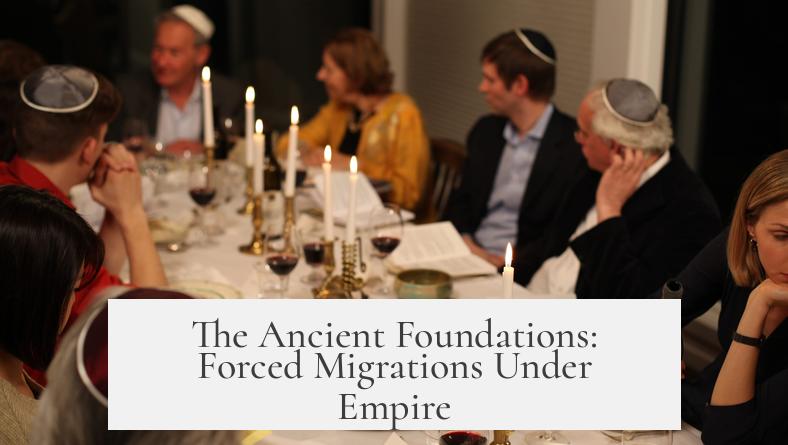Jews have been expelled from many countries over centuries due to a complex mix of historical, religious, social, economic, and political factors rather than intrinsic traits of the Jewish people. These expulsions stem from deep-rooted tensions between Jewish minority communities and majority societies, shaped by varying contexts across different eras and regions.
In antiquity, early forced displacements involved whole populations. The Assyrian conquest of the Northern Kingdom of Israel in 722 BCE led to the exile of the so-called Ten Lost Tribes. Similarly, the Babylonian conquest of Judah around 586 BCE took Jewish elites into exile. These events represented general practices of imperial powers managing conquered peoples rather than unique targeting of Jews.
The Roman era brought specific conflicts between Jewish communities and imperial authority. Jews’ refusal to partake in emperor worship and suspicions of secret cults created tensions. The Jewish revolts against Rome, notably the Bar Kokhba Revolt (132–136 CE), led to crushing defeats, the destruction of the Temple in Jerusalem, and widespread death, enslavement, and exile of Jews. This marked a major dispersal of Jewish populations outside Judea.
During the medieval and early modern period in Christian Europe, expulsions became more systemic. As Christian states sought religious uniformity, Judaism held a unique minority status. Jews were often the sole religious minority tolerated, which paradoxically rendered them vulnerable. They could be expelled while Christian “heretics” faced different forms of persecution.
State formation processes profoundly influenced expulsions. For example, the 1290 expulsion of Jews from England and similar actions in France around the same time were linked to negotiations between royalty and nobility. Kings often owed debts to Jewish bankers and used expulsions to solve financial and political conflicts. Historian Charles Tilly connects these acts to the centralization of modern states in Western and Northern Europe.
Jews also served as scapegoats during crises such as plagues. Accusations of well-poisoning and blood libel (false claims of ritual murder) seemed to intensify expulsions. Blood libel accusations originated in Christian Europe and only reached the Islamic world in the 19th century through Christian influence, highlighting their contextual nature.
The treatment of Jews differed in Muslim lands due to unique legal and social frameworks. Under the millet system, Jews and Christians were recognized as protected, though unequal, minorities. This status often provided Jews with greater stability and fewer expulsions compared to Europe. Jewish communities persisted in Anatolia, North Africa, Mesopotamia, Arabia, and Persia until rising nationalism altered these dynamics.
Nationalism, emerging primarily in the late 18th and 19th centuries, redefined political identity around ethnic or cultural uniformity. Expulsions became tools for creating cohesive nation-states. The 1492 expulsion of Jews (and Muslims) from Spain illustrates this trend, establishing a Catholic Spanish nation. In France, Protestant expulsions aimed to enforce religious homogeneity. Jews faced growing pressure to assimilate or be excluded as states equated national membership with cultural conformity.
Jewish emancipation following the French Revolution granted legal citizenship but did not end suspicion or exclusion. Controversies like the Dreyfus Affair in late 19th-century France and the stripping of German Jews’ rights under Nazism exemplify the persistent challenges to Jewish belonging in nation-states.
The strong Jewish cultural and communal identity also contributed to recurrent expulsions. Jewish self-understanding combined religious, genetic, and community aspects that emphasized maintaining a distinct identity in foreign lands. This separateness made Jewish communities identifiable targets during periods of social tension and reinforced their status as outsiders.
The role of the Catholic Church shaped European perceptions heavily. By blaming Jews for the death of Christ for centuries, the Church entrenched negative stereotypes that fueled hostilities.
Economic factors often precipitated expulsions too. Jewish bankers and merchants filled vital roles in medieval economies, yet rulers expelled Jews to avoid debt repayment or to confiscate property. Frequently, expulsions were followed by readmissions when states required Jewish economic functions again, producing cycles of exclusion and return.
| Period | Primary Drivers of Expulsions | Notes |
|---|---|---|
| Antiquity | Military conquest and forced exile | Exiles under Assyrians and Babylonians; displacement not unique to Jews |
| Roman Era | Jewish revolts and refusal of imperial cult | Destruction of Temple; mass deportations and enslavement |
| Medieval Christian Europe | Religious intolerance, state formation, economic motives, scapegoating | Exclusive minority status; expulsions tied to politics and crises |
| Islamic Empires | Protected minority status under millet system | Relative stability and fewer expulsions until nationalism |
| Early Modern/Nationalism | Nation-state building and demands for cultural homogeneity | Expulsions of Jews and other minorities to define national identity |
Modern social science highlights expulsions as consequences of political power struggles, economic interests, religious prejudice, and societal crises. Repeated expulsions do not derive from any inherent Jewish quality but from complex intergroup dynamics in differing historical and social contexts.
- Antiquity expulsions were typical imperial strategies, not unique targeting.
- Medieval expulsions linked to state formation, financial motives, and religious scapegoating.
- Muslim legal frameworks generally allowed better Jewish minority stability than Christian Europe.
- Nationalist movements intensified pressures to expel or assimilate Jews.
- Jewish communal identity and historical religious prejudice made Jews distinct targets.
- Economic utility led to cycles of expulsion and readmission.
- Expulsions reflect socio-political struggles, not intrinsic Jewish traits.
Why Have Jews Been Expelled in So Many Countries?

Jews have faced expulsions in numerous countries throughout history due to a complex mix of religious, economic, political, and cultural reasons rather than any single cause. The story of these expulsions reveals much about the societies that rejected them and the enduring Jewish identity that resisted assimilation.
Let’s journey through this multifaceted history to understand why Jewish communities have been repeatedly uprooted across the centuries, yet have also managed resilience and continuity.
The Ancient Foundations: Forced Migrations Under Empire

The saga begins long before Europe’s medieval turmoil. In 722 BCE, the Assyrian Empire conquered the Northern Kingdom of Israel, deporting much of its population—these are the “Ten Lost Tribes.” Sad, but here’s an interesting note: this expulsion wasn’t uniquely targeting Jews but was a common imperial tactic for managing conquered lands.
Later, in 586 BCE, Babylon seized the Southern Kingdom of Judah, deporting elites in what’s known as the Babylonian exile. Again, Jews weren’t singled out as special troublemakers but were victims of imperial conquest.
Fast forward to the Roman era, where things get trickier. Jews stood apart due to their refusal to worship the emperor and suspicion around their secret religious rites. The wars against Rome culminated in the devastating destruction of the Second Temple and massive displacement or death of Jewish populations after the Bar Kokhba Revolt (132–136 CE). This marks a pivotal moment—Jews were no longer just victims of empire but occupants of an uneasy place in imperial politics.
Medieval Europe: The Only Minority in a Christian World

Medieval Europe was predominantly Christian. In fact, no other religions were officially acknowledged inside most Christian kingdoms, except for Judaism. This unique minority status paradoxically made Jews both necessary and vulnerable.
They were allowed to live because they served essential economic roles, especially as money lenders in a Christian world where usury was taboo for Christians. Yet, this made them easy scapegoats. When kingdoms wanted to cancel debts or solidify power, Jews were convenient targets.
History’s greatest hits of expulsions—England in 1290, France around the same time—weren’t pure acts of religious hatred but rather results of complicated negotiations between royalty and nobility during early state formation. Kings expelled Jews partly because it was politically expedient and economically beneficial to erase debts owed to Jewish bankers. Meanwhile, nobles aimed to curtail royal financial leverage.
Charles Tilly, a notable historian, explains these mass expulsions as part of the broader European trend toward centralizing state power. Medieval expulsions weren’t random—they were strategic moves within the chess game of forming modern Europe.
Cultural Cohesion and Religious Tensions: A Recipe for Otherness

Jews maintained a strong community, religious, and cultural identity, dating back some 3,000 years. This cultural cohesion meant that Jewish communities often separated themselves, maintaining distinct religious practices and communal bonds rather than blending into the dominant culture.
This separateness was both a source of pride and a cause for suspicion. When political or economic tensions mounted, Jews could become the “other,” easy to blame during societal crises.
The Catholic Church also played a significant role in shaping European attitudes. For centuries, it accused Jews of being responsible for the death of Christ—once the kind of religious slander that, frankly, would make anyone unpopular at the village gathering.
Scapegoats in Times of Crisis: Plagues and Blood Libels

Throughout the Middle Ages, expulsions often took place amid epidemics and social upheavals. Plagues, especially in Germany, triggered accusations against Jews of poisoning wells—completely baseless but terrifying enough to spark violence, expulsions, and massacres.
Similarly, blood libel accusations—absurd claims that Jews murdered Christian children for ritual purposes—fueled persecution. Interestingly, these accusations were largely absent from the Islamic world until introduced there in the 19th century by Christian influence, highlighting how Christian Europe’s attitudes deeply shaped Jewish fate.
Comparing the Christian and Islamic Worlds

Jewish experiences differed markedly between Christian Europe and the Islamic empires. Under Muslim rule, Jews—and Christians—were considered dhimmi, a form of protected minority with certain restrictions but legal protection and social stability.
This “millet” system allowed Jewish communities in places like Anatolia, North Africa, and Persia to live with fewer expulsions and persecutions compared to Europe. Granted, sometimes rights were violated, but generally, the framework offered more predictability and safety.
So why then the stark contrast? It largely boiled down to differing legal frameworks and the absence of religious exclusivity that defined many Christian states. Muslim rulers were often pragmatic, tolerant minorities for a mix of religious doctrine and political expediency.
The Rise of Nationalism and Modern Expulsions

Jumping to the Early Modern period, the French Revolution sparks modern nationalism—where a state claims legitimacy through representing a titular national culture. This shift changes everything.
Nationalism demands cultural and religious homogeneity, meaning minorities like Jews face new pressures. Spain’s 1492 expulsion of Jews and Muslims exemplifies this: it’s not just religion, but the political need to forge a unified nation-state pushing out minorities.
France teeters on a similar edge, expelling Protestants during the Wars of Religion to create a strictly Catholic state. This illustrates how nation-building often meant exclusion of those perceived as outside the core identity.
Jewish emancipation—the granting of equal citizenship rights—only emerges after the French Revolution. Even then, debates linger into the 19th and 20th centuries, as with the infamous Dreyfus Affair in France or the horrifying disenfranchisement under Nazi Germany. It’s a long climb toward inclusion, often met with backlash.
Economic Cycles: Expulsions and Readmittances
Here’s a plot twist: Jews have often been expelled but also readmitted repeatedly. Why the back-and-forth? Economics.
States expelled Jews to erase debts or appease religious radicals but quickly accepted them back because Jewish financiers provided crucial credit services. The economic necessity was often stronger than religious or xenophobic motives—though that didn’t mean the Jewish communities were safe once inside.
This cycle of financial utility producing reluctant tolerance followed by expulsion when politics shifted explains why the Jewish story in Europe is one of continual exile and return.
What Does Modern Research Tell Us?
Social scientists today agree that expulsions stemmed from Jewish status as the most visible and tolerated religious minority in Christian Europe. Their fate was caught up in the dynamics of power, economic interest, religious conflict, and cultural identity.
Crusades, Catholic revivals, the Reformation, and nationalism all shaped waves of expulsions. Notably, expulsions reflect the reluctance of societies to accommodate persistent minority difference rather than any trait inherent to Jewish identity.
Why Does This Matter Today?
Understanding the historical reasons Jews were expelled reveals patterns of othering and scapegoating that recur worldwide against minorities. It teaches us about the dangers of defining nations or societies in narrow cultural or religious terms.
It also highlights the resilience of communities that maintain identity amid displacement and adversity. By appreciating the nuanced causes—economic power, religion, politics, persistent cultural distinctiveness—we move beyond simplistic stereotypes and acknowledge a tangled historical reality.
In Closing: A Tale of Persistence Against the Odds
Throughout millennia, Jewish communities have faced forced migrations, expulsions, and discrimination fueled by empire politics, religious intolerance, economic calculations, and nationalistic pressures.
Yet, their continuance as distinct cultural and religious communities tells a story of endurance, adaptation, and a steadfast commitment to identity.
So, next time someone asks, “Why have Jews been expelled in so many countries?” you can answer:
Because they were caught in historical crossfires of power struggles, religious intolerance, economic needs, and their strong community identity that refused to simply disappear into the cultural background. A tough position to be in, and yet, a testament to resilience.
Is history repeating itself when societies exclude others to build identity? What lessons can we draw about tolerance and inclusion today? Those questions remain as pressing now as ever.
Why were Jews expelled during the formation of modern European states?
Expulsions often came as part of state formation. Monarchs and nobles negotiated to reduce debt owed to Jewish bankers. Expelling Jews helped centralize power and unify territories under one rule.
How did accusations like blood libel influence Jewish expulsions?
False claims such as poisoning wells or blood libel often preceded expulsions. These accusations appeared during social crises, particularly plagues, and were used to scapegoat Jewish communities.
Why were expulsions less common in Muslim lands compared to Christian Europe?
In Muslim empires, Jews were protected minorities under the millet system. This status gave them legal recognition and relative stability, reducing the frequency of expulsions found in Europe.
What role did nationalism play in the expulsion of Jews?
Nationalism sought cultural and religious unity in new nation-states. Jews, as distinct minorities, were often expelled or pressured to assimilate to enforce uniform identity.
How did Jewish cultural identity affect their treatment in foreign lands?
Jews maintained strong communal bonds and distinct cultural identities. This resistance to assimilation made them visibly different, which sometimes led to tension and expulsions by majority populations.




